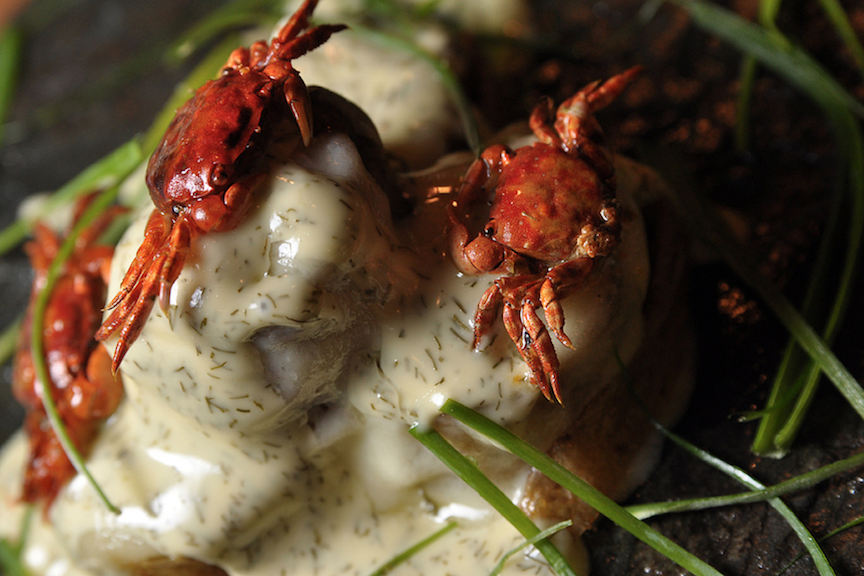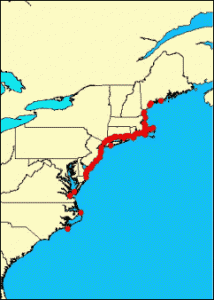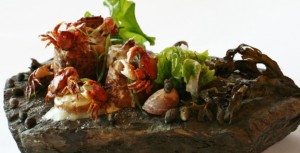
Hemigrapsus sanguineus
Native range: Western Pacific Ocean from Russia to Hong Kong, Japan
Invasive range: Maine to North Carolina
Habitat: Intertidal. Often found in dense aggregations under rocks. Common on artificial mussel beds and oyster reefs.
Description: Adults are small, about an inch and a half in shell width. Square shell. Light and dark bands on legs.
The first sighting of the Asian shore crab in the United States was at Townsend Inlet, Cape May County, New Jersey, in 1988. Though the source is unknown, it is likely that the crabs were discharged as larvae from the ballast water of a cargo ship. The transfer of larvae around the world in ballast tanks is a form of “ocean roulette,” with each ship a potential chamber ready to discharge a new, unwanted species.
Along the Atlantic intertidal coastline from Maine to North Carolina, this crab is now breeding and increasing rapidly in number. Because it tolerates a wide range of environmental conditions, it seems all too likely to continue to multiply and to spread. Because it is not a picky eater, it outcompetes native species such as crabs, fish, and shellfish for food–-or it eats them, being an opportunistic omnivore that feeds on algae, saltmarsh grass, larval and juvenile fish, and small invertebrates such as amphipods, gastropods, bivalves, barnacles, and worms. Did we leave out anything smaller than a small crab’s mouth? That wide-ranging appetite and the growing population threaten both coastal ecosystems and aquaculture operations.
This invasive shore crab takes over habitats normally occupied by native mud crabs. It can compete with larger species, such as the blue crab, rock crab, lobster, and even another invader, the European green crab. The Asian shore crab breeds from May to September, twice as long as many native crabs. Females can produce 50,000 eggs per clutch, and 3 to 4 clutches per season. Suspended in tidal water for a month before developing into juvenile crabs, the larvae can be transported over great distances, a possible means of new introductions. And now tsunami debris from Japan has crossed the Pacific Ocean to Oregon and brought the Asian shore crab–-and lots of other species hanging on for the ride–-to the West coast of the United States for its first documented appearance.
Harvest
Check under rocks and in tide pools at low tide. Read more on how to identify Asian shore crabs here.
Recipes
Bun Lai, owner of Miya’s Sushi in New Haven, Connecticut, is one of the few chefs who proudly serves invasive species. His dish Kanibaba, which combines fried Asian shore crabs with sustainable sushi rolls, is designed to look like the craggy seashore home of these tiny invaders.
Below is one of Lai’s simple recipes.
Asian Crab Popcorn
Collect about 30 small Asian shore crabs
Olive oil for frying
Chile pepper to taste
Lime
Old Bay Seasoning
In a large pan, heat oil for frying.
Submerge the crabs in oil. (Be careful with splatter.) Add chile pepper to the oil. The crabs will turn a beautiful orange as they cook, and are done when they are no longer releasing water: about 15 minutes.
Remove the crabs from the oil with a slotted spoon and place on paper towels to drain.
Squeeze lime and then sprinkle Old Bay Seasoning over the crabs.
Serve while hot.
For a demonstration, see this video from ABC News.
And here’s Bun, no holds barred, on Connecticut Style.
Sawagani on Grilled Pineapple Salsa with Tabasco
The folks at Tabasco have developed a recipe for Asian shore crabs, or sawagani, which can be found on their website here.
E. A. McIlhenny, who branded the sauce, also helped establish the invasive nutria in New Orleans, in an attempt to bolster the local fur industry.
Asian Shore Crabs in Coconut Milk, Filipino style
Adapted from Panlasang Pinoy Recipes.
Approximately 25 Asian shore crabs
8 to 10 taro leaves with stalks, shredded and wilted (available in many Asian markets)
4 to 5 green peppers (jalapeño or Thai)
5 to 6 cloves of garlic, minced
2 tbsp. minced ginger
1 can coconut milk (coconut cream can also be prepared)
1 medium onion, minced
salt to taste
Wash shore crabs and drain.
In a large pan, sauté garlic, ginger, onion, and green peppers, in olive oil.
Add coconut milk.
When milk boils, add taro leaves and stalks. Simmer for about 30 minutes.
Add crabs. Cook until sauce thickens.






























{ 7 comments… read them below or add one }
As someone who’s never eaten a crab I feel that two pieces of information missing from this page that would be helpful to me are:
1) Do you eat the shell?
2) How to kill the crab (from a practical and ethical perspective).
Thanks so much for your spiritual-ecological activism.
Z
These are small crabs, so, yes, you eat them whole, shell and all. One way to kill them before cooking is to put them in the freezer before cooking.
Ok, I’m Chinese, specifically Cantonese. We are known for eating anything. These little crabs are delicious! We’ve been eating it forever – I never heard of anyone getting poisoned from cooking these little crabs, no need to gut them. Some regions in south China and southeast Asia even pickle them without cooking – however, I’m pretty sure they clean and gut them before eating raw (unfortunately I’m not familiar with the process).
So one good way to enjoy these little crabs are deep-frying. To clean, soak them in water with salt and flour for a few minutes first, then rinse them. Repeat for two or three times. Then drain it, coat a thin layer of flour, deep fry it until it’s golden brown.
Then, mix it with stir-fried minced meat and deep-fried garlic, and you’ll have a wonderfully crispy and delicious salad. Serve with crunchy raw vegetables and rice.
At my dentist’s waiting room, I read about this invasive species. Shore crabs are a Philippine delicacy.
When I normally eat crabs (blue crabs) we remove the lungs/guts. Even with a soft shell crab you cut out a few sections before eating.
Is it safe to eat large quantities of these little shore crabs without gutting them first? Has anyone tested their levels of PCB’s, heavy metals, or other toxins?
Could these eggs help to save the Red Knots and other shore birds? With the harvesting of Horseshoe crabs, we’ve had a crisis in the migration on the East Coast, with many migrating shorebird populations heading towards zero. If these little crabs and their eggs could fill that gap, it would be amazing….
It would be wonderful if we could use invasive crabs instead of horseshoe crabs in the bait industry. Since Asian shore and horseshoe crabs are found in different habitats, I’m not sure if we can train the red knots to eat these invaders.